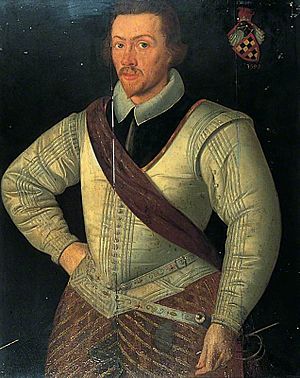Conyers Clifford facts for kids
Quick facts for kids
Sir
Conyers Clifford
|
|
|---|---|
 |
|
| Lord President of Connaught | |
| In office 4 September 1597 – 15 August 1599 |
|
| Monarch | Elizabeth I |
| Preceded by | Richard Bingham |
| Succeeded by | Richard Burke |
| Member of Parliament for Pembroke |
|
| In office 18 February 1593 – 10 April 1593 |
|
| Preceded by | Nicholas Adams |
| Succeeded by | Edward Burton |
| Personal details | |
| Born | 1566 Kent, England |
| Died | 15 August 1599 (aged 32–33) Curlew Pass, County Roscommon, Ireland |
| Resting place | Holy Trinity Abbey, Lough Key, County Roscommon |
| Spouse | Mary Southwell (d. 1603) |
| Children | Conyers Clifford Henry Clifford Frances Clifford |
| Alma mater | University of Cambridge |
| Military service | |
| Allegiance | |
| Branch/service | English Army |
| Years of service | 1591–1599 |
| Rank | |
| Battles/wars | Eighty Years' War • Siege of Rouen Anglo-Spanish War • Capture of Cádiz Nine Years' War • Battle of Curlew Pass |
Sir Conyers Clifford (born around 1566, died 1599) was an important English leader. He was known for his skills as a politician and a military commander. He served Queen Elizabeth I during a time of many conflicts.
Contents
Who Was Sir Conyers Clifford?
Conyers Clifford was born in Kent, England, around 1566. His father was George Clifford. Conyers later inherited his family's home, Bobbing Court. He studied at the University of Cambridge, where he earned a Master of Arts degree in 1595.
Early Military Career
Clifford began his military career as a captain. In 1591, he joined the English army fighting in France. This army was led by Robert Devereux, 2nd Earl of Essex. During the siege of Rouen, Clifford showed great bravery. He helped rescue the body of the Earl of Essex's brother, who had been killed in battle. For his courage, Conyers Clifford was made a knight that same year. This meant he could now be called "Sir Conyers Clifford."
Political Role and Further Battles
In 1593, Sir Conyers Clifford also became a politician. He was elected to the English Parliament, representing the town of Pembroke.
His military adventures continued. In 1596, he joined a major English expedition against Cadiz in Spain. He served as a high-ranking officer, helping to plan the attack. The English forces successfully captured Cadiz.
Leading in Ireland
In 1597, Sir Conyers Clifford was given a very important job in Ireland. He was appointed the President of Connaught. This meant he was in charge of the province of Connaught, leading soldiers and keeping order. Before this, he had already been working as a chief official in the area and was in charge of Athlone Castle.
During the Nine Years' War in 1599, the Earl of Essex planned a large military campaign in Ireland. He ordered Sir Conyers Clifford to lead his troops from Connaught into Ulster. The goal was to split the forces of Hugh Ó Neill, 2nd Earl of Tyrone, a powerful Irish leader.
The Battle of Curlew Pass
In August 1599, Sir Conyers Clifford led about 1,500 foot soldiers and 100 horsemen. They marched towards the Curlew Mountains in County Roscommon. The Irish forces, led by Brian Óg O'Rourke, had blocked the mountain pass.
As Clifford's soldiers tried to get through, they were attacked by the Irish. This led to the Battle of Curlew Pass. The English soldiers ran low on ammunition and became scared. They started to flee. During the battle, Sir Conyers Clifford was badly wounded by a pike and died.
His death was a big loss for the English. However, even the Irish leaders respected him. They said he "never told them a falsehood." Sir Conyers Clifford was buried with honor at Holy Trinity Abbey in Lough Key.
Family Life
Sir Conyers Clifford was married to Mary Southwell. Together, they had two sons, Henry and Conyers, and a daughter named Frances. Mary Clifford later married Sir Anthony St Leger. She passed away in 1603.

